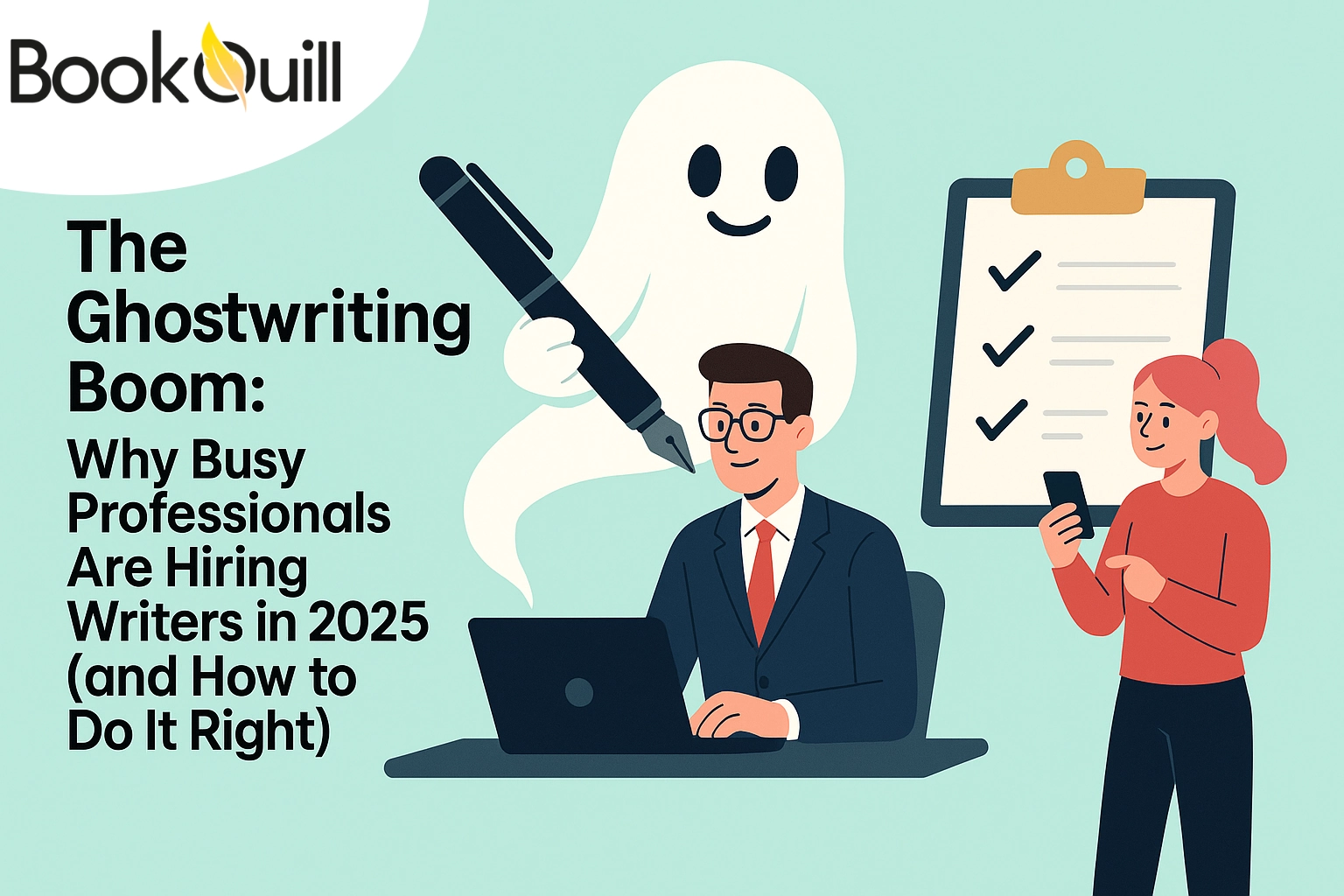Table of Contents
Explore Blogs
Trending on Ebook
How to Design a Book Cover That Grabs Attention

Ever been strolling past a bookstore, and something just caught your eye? Maybe it was the eye-catching cover of a book, with its eye-popping colors and intriguing illustrations, that made you stop in your tracks. You feel an instant pull to find out more. Before you know it, you are inside the cozy little shop, holding that book in your hands, flipping through its pages.
The cover didn’t just grab your attention—it sparked a connection, hinting at the adventure, mystery, or vast knowledge waiting inside. You should make a cover just like that for your book, too. But how? You will learn in this blog.
Key Takeaways
- Cover is the Face of Your Book– Make it count by aligning the design with your book’s genre and target audience.
- Typography and Colors Matter – Choose fonts and colors that match your book’s vibe while keeping the design clean and readable.
- Back Cover Design Counts Too – Include a synopsis, reviews, and teasers to make the back as engaging as the front.
- Don’t Hesitate to Seek Help – Whether you choose an affordable custom book design or a premium one, professionals can elevate your book’s appeal.
- Understand Digital vs. Print Needs – Ensure your cover works well as a thumbnail for online stores and has proper dimensions for print.
- Test Your Design – Share your cover with others and adjust based on feedback to ensure it grabs attention.
Why to Have an Appropriate Cover
Your book cover is like your book’s handshake—it’s the first impression people get. If it’s sloppy, generic, or just doesn’t “vibe,” readers might assume the content is the same. Put yourself in their shoes: would you pick up a thriller with a pastel, flowery design? Probably not. A great book cover design not only looks good but tells people what your book is about.
Let’s not forget digital platforms if you’re going to put your book there for sale. On sites like Amazon, your book cover is reduced to a tiny thumbnail. If it doesn’t pop, your book’s toast.
Know Your Audience
According to a survey conducted by Research Gates, “women aged 18-35 prefer books with cool-colored covers, and this preference diminishes with age. Conversely, men aged 56 and above prefer books with warm-colored covers”. Therefore, fonts and colors should be chosen according to the age group of your target audience. You need to figure out who is going to read your book before selecting them. Is it young adults, history buffs, or thriller fans? The vibe of your cover design must match the audience.
If your book’s a romance, think soft colors and cute fonts. Writing a dark, twisty mystery? Go for bold imagery and moody tones. Premium book design services are great at nailing these shades, but if you are going the DIY route, you should spend some time researching other books in your genre.
For a Great Book Cover, What Do You Need?
A dull cover won’t grab your audience’s attention, but a great one can draw their interest. Focus on these essential elements to make your design stand out among others:
Typography That Speaks Volumes
Your title should stand out without trying too hard. Fonts carry a lot of personality, so pick one that fits your book’s theme. For instance, a thriller might use sharp, bold letters, while a romance might lean on elegant, flowing scripts.
Colors That Pop
Colors are like the mood-setters of your book cover. Blues and greens feel calm, reds and oranges scream energy, and black and gray give off secret sensations. The right palette can define the overall feel of your book and capture the reader’s attention in an instant. Do you need inspiration? Check out the best cover design service for examples that knock it out of the park.
Imagery That Seizes Attention
Let’s not overdo it here. A single, strong image works way better than cluttered designs. Whether it’s a dramatic landscape, a mysterious figure, or an abstract shape, make sure it speaks to your story.
Back Cover Matters, Too
Wondering what the back cover of a book looks like? It’s prime real estate! This is where you include a short synopsis, reviews, and maybe even a teaser. Don’t just slap text on there—make it cohesive with the front.
Matching the Cover to the Genre
You would never put a sci-fi spaceship in a cookbook, right? Your book cover should tell people what kind of story they’re getting into.
Here’s a cheat sheet:
- Romance – Soft colors, dreamy imagery, flowing fonts
- Fantasy – Intricate details, dramatic lighting, otherworldly visuals
- Thriller – Dark tones, sharp contrasts, bold fonts
- Non-fiction – Clean, minimalist, often text-focused
DIY vs. Professional Help
There are two ways to design your cover: you can DIY or hire cover design services. Which option should you go with? Below, you will get your answer:
DIY Route
If you’re confident in your design skills, tools like Canva or Adobe InDesign can be lifesavers. Just remember, a bad book cover design can cost you readers. It’s worth investing time (and maybe a little cash) to make it shine.
Professional Help
Not feeling creative? No shame in that. The best book design services can take your ideas and turn them into something stunning. Before you hire an affordable designer or any other professional to start working on your book’s cover, share your vision clearly.
Digital vs. Print Covers
Designing for digital and print is not the same. Online, your book cover is often shrunk to thumbnail size, so it needs to be clean and simple.
Statista has stated that in 2023, a total of 767.36 million printed books were sold that year among outlets. This emphasizes the importance of a compelling cover in a highly competitive market for print books. The question of how long a book should be covered depends on the size of the book.
Don’t forget the spine and back cover—these need just as much love. A well-designed spine and back cover can enhance the appeal of your book and make it stand out on both digital and physical shelves.
Common Book Cover Mistakes to Avoid
Have a look at what not to do:
Too Much Going On
Cluttered designs scream “amateur.” Less is more for book covers. Overloading a cover with too many images, fonts, and colors can confuse potential readers and make it hard for them to focus on the main message. It’s important to prioritize simplicity and clarity.
A clean, well-organized design not only looks professional but also prominently emphasizes key elements, like the title and author’s name. Your cover should give a quick, impactful glimpse of your book’s essence, not overwhelm the viewer.
Generic Stock Images
Nothing kills originality faster than overused photos. Using generic stock images can make your book’s cover look like a dozen others on the shelf, which is the opposite of what you want. A unique, custom image or illustration can convey your book’s unique story and tone more effectively.
It’s worth investing in original artwork that captures the essence of your narrative and sets your book apart from the rest. A distinctive cover can attract attention and leave a lasting impression on potential readers.
Unreadable Fonts
Funky fonts might look cool, but if no one can read your title, what’s the point? You should choose fonts that are legible and appropriate for your book’s genre. Overly decorative or complex fonts can be hard to read on the book’s cover, especially in smaller sizes or on digital platforms.
Aim for a balance between style and readability. The title and author’s name should be clear and prominent. A good font choice can enhance the overall design and make your cover more appealing and accessible to readers.
Testing and Feedback
You wouldn’t launch a book without editing, so don’t finalize a cover without feedback. Show your design to friends, beta readers, or even strangers. Better yet, run a poll on social media. You might be surprised by what people like.
Covers That Nailed It
Covers aren’t just pretty—they tell you what the book’s about. That’s the goal of any amazing book cover design. Let’s look at a few examples:
The Night Circus
1. Color Palette
In the book, “Night Circus,” the use of black, white, and red immediately hints at mystery and magic. These colors are not just visually striking but also evoke a sense of the fantastical and otherworldly themes present in the book.
2. Imagery and Graphics
The cover often features circus elements, like tents or performers, which directly relate to the story’s setting.
3. Typography
The elegant and whimsical font choice complements the magical theme and adds to the sense of wonder.
4. Why It Worked
- Instant Connection – The cover immediately communicates the genre and tone of the book. Potential readers can quickly grasp that this is a tale of enchantment and mystery.
- Consistency – The book cover’s design is consistent with the content, which saves readers from being misled.
- Aesthetic Appeal – The bold and contrasting colors grab attention and make the book stand out on a shelf or in a digital thumbnail.
Eleanor Oliphant Is Completely Fine
1. Typography
The simple yet striking typography is a key feature. The handwritten style adds a personal touch, hinting at the deeply personal and introspective nature of the story.
2. Imagery
The illustration of a woman with crossed arms against a plain background in the book “Eleanor Oliphant Is Completely Fine” intrigues readers and gives them hints at the protagonist’s struggles and the theme of resilience.
3. Color Palette
The use of warm, muted tones creates a sense of comfort and relatability, which aligns with the book cover’s themes of personal growth and human connection.
Why It Worked
- Emotional Connection – The cover manages to evoke curiosity and empathy, prompting potential readers to explore the protagonist’s journey.
- Clarity – The design is clean and uncluttered, making it easy to understand at a glance.
- Reflective of Content – The imagery and typography work together to give a glimpse into the story, ensuring that readers know what to expect.
Tips for Designing the Best Cover
- Keep your title front and center.
- Don’t avoid bold colors or strong contrasts.
- Always think about how the cover looks in different sizes.
Final Thoughts
Designing a book cover isn’t rocket science, but it’s not a walk in the park, either. Whether you’re figuring out how to design a book cover for the first time or tweaking an existing one, remember that they can influence readers’ decisions to buy it.
If you are still feeling stuck, check out design services to make your book shine. After all, a good cover isn’t just about aesthetics—it’s about getting readers to open your book.
FAQs
What file formats are best for book cover design?
Most publishers and platforms require high-resolution files in formats like PDF, JPEG, or PNG. Adobe InDesign and Photoshop are popular tools for creating these files. Ensure the resolution is at least 300 dpi for print and optimized for smaller sizes in digital formats.
What does the back cover of a book look like for different genres?
A back cover typically includes a synopsis, author bio, and endorsements. Fiction often focuses on enticing blurbs, while non-fiction highlights credentials and benefits to the reader. Tailor the tone and content to your target audience.
How much does it cost to hire a cover design service?
Costs vary depending on the designer’s experience. Affordable options may start at around $100, while premium options can cost several hundred dollars. Budgeting based on your book’s marketing goals is key.
Can I update my book cover after publishing?
Yes, you can! Many self-publishing platforms like Amazon allow you to upload a new book cover if you want to refresh the look or fix issues. Make sure to maintain branding consistency if you update it.
How do I know how long should a book cover be?
The length depends on the book’s trim size and spine width, which are determined by the number of pages. Most print-on-demand services provide templates, so use these to ensure accuracy.
About Author
Hi, my name is Zachary Stone I’m a book marketing nut — or, as I like to call myself, a “Shelf Marketer.” No, I don’t sell wooden shelves; I market the books that are left forgotten on them. If you want your book to be the next bestseller, I am your go-to person. I am here to remind you that it’s not just about writing a great story — it’s about building a buzz among people with great campaigns.




